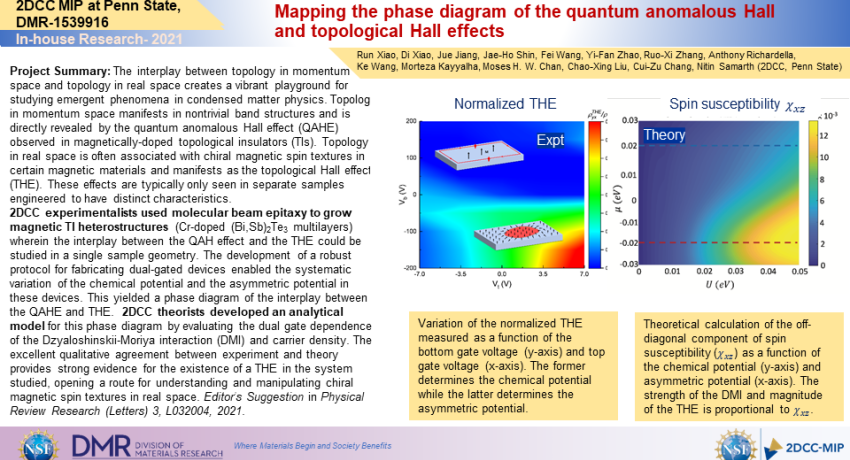Project Summary: The interplay between topology in momentum space and topology in real space creates a vibrant playground for studying emergent phenomena in condensed matter physics. Topology in momentum space manifests in nontrivial band structures and is directly revealed by the quantum anomalous Hall effect (QAHE) observed in magnetically-doped topological insulators (TIs). Topology in real space is often associated with chiral magnetic spin textures in certain magnetic materials and manifests as the topological Hall effect (THE). These effects are typically only seen in separate samples engineered to have distinct characteristics.
2DCC experimentalists used molecular beam epitaxy to grow magnetic TI heterostructures (Cr-doped (Bi,Sb)2Te3 multilayers) wherein the interplay between the QAH effect and the THE could be studied in a single sample geometry. The development of a robust protocol for fabricating dual-gated devices enabled the systematic variation of the chemical potential and the asymmetric potential in these devices. This yielded a phase diagram of the interplay between the QAHE and THE. 2DCC theorists developed an analytical model for this phase diagram by evaluating the dual gate dependence of the Dzyaloshinskii-Moriya interaction (DMI) and carrier density. The excellent qualitative agreement between experiment and theory provides strong evidence for the existence of a THE in the system studied, opening a route for understanding and manipulating chiral magnetic spin textures in real space. Editor’s Suggestion in Physical Review Research (Letters) 3, L032004, 2021.
What Has Been Achieved: Developed dual-gated magnetic topological heterostructures that manifest both the quantum anomalous and topological Hall effects as a function of the dual-gate voltages.
Importance of the Achievement: This work provides a robust pathway for producing samples that enable the fundamental study of the interplay between Berry curvature in momentum space and real space. These unique samples and patterned devices are available for users as sample requests.
Unique Feature(s) of the MIP that Enabled this Achievement: 2DCC-MIP’s synthesis capabilities of magnetically-doped topological insulator heterostructures.
(If Applicable) Publication:
Run Xiao, Di Xiao, Jue Jiang, Jae-Ho Shin, Fei Wang, Yi-Fan Zhao, Ruo-Xi Zhang, Anthony Richardella, Ke Wang, Morteza Kayyalha, Moses H. W. Chan, Chao-Xing Liu, Cui-Zu Chang, and Nitin Samarth, Mapping the phase diagram of the quantum anomalous Hall and topological Hall effects in a dual-gated magnetic topological insulator heterostructure, Phys. Rev. Research 3, L032004
https://doi.org/10.1103/PhysRevResearch.3.L032004
The synthesis of samples was supported by the National Science Foundation (NSF) 2DCC-MIP (Grant No. DMR-1539916). The dilution electrical transport measurements were supported by Department of Energy (DOE) Grant No. DE-SC0019064, the Gordon and Betty Moore Foundation's EPiQS Initiative (Grant No. GBMF9063 to C.-Z.C.), and NSF (DMR-1707340). The electrical transport measurements >400 mK were supported by the Institute for Quantum Matter under DOE Energy Frontier Research Centers Grant No. DE-SC0019331. The theoretical calculations were also supported by DOE Grant No. DE-SC0019064.
